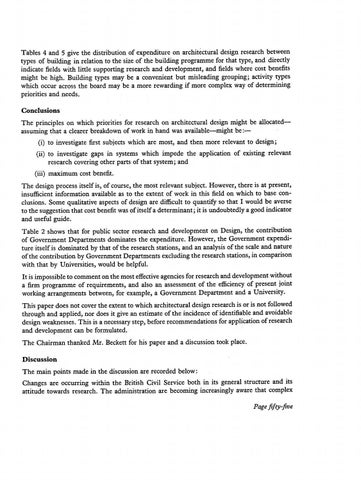Tables 4 and 5 give the distribution of expenditure on architectural design research between types of building in relation to the size of the building programme for that type, and directly indicate fields with little supporting research and development, and fields where cost benefits might be high. Building types may be a convenient but misleading grouping; activity types which occur across the board may be a more rewarding if more complex way of determining priorities and needs. Conclusions The principles on which priorities for research on architectural design might be allocated— assuming that a clearer breakdown of work in hand was available—might be :to investigate first subjects which are most, and then more relevant to design; to investigate gaps in systems which impede the application of existing relevant research covering other parts of that system; and maximum cost benefit. The design process itself is, of course, the most relevant subject. However, there is at present, insufficient information available as to the extent of work in this field on which to base conclusions. Some qualitative aspects of design are difficult to quantify so that I would be averse to the suggestion that cost benefit was of itself a determinant; it is undoubtedly a good indicator and useful guide. Table 2 shows that for public sector research and development on Design, the contribution of Government Departments dominates the expenditure. However, the Government expenditure itself is dominated by that of the research stations, and an analysis of the scale and nature of the contribution by Government Departments excluding the research stations, in comparison with that by Universities, would be helpful. It is impossible to comment on the most effective agencies for research and development without a firm programme of requirements, and also an assessment of the efficiency of present joint working arrangements between, for example, a Government Department and a University. This paper does not cover the extent to which architectural design research is or is not followed through and applied, nor does it give an estimate of the incidence of identifiable and avoidable design weaknesses. This is a necessary step, before recommendations for application of research and development can be formulated. The Chairman thanked Mr. Beckett for his paper and a discussion took place. Discussion The main points made in the discussion are recorded below: Changes are occurring within the British Civil Service both in its general structure and its attitude towards research. The administration are becoming increasingly aware that complex Page fifty-five
The Application of Architectural Research to Practice, 1972

Issuu converts static files into: digital portfolios, online yearbooks, online catalogs, digital photo albums and more. Sign up and create your flipbook.










